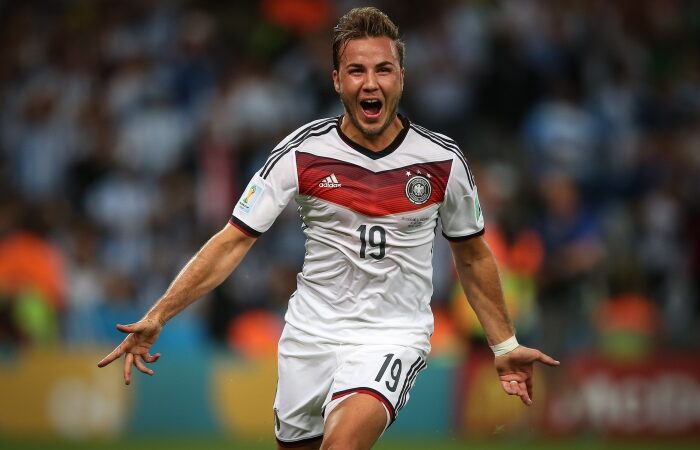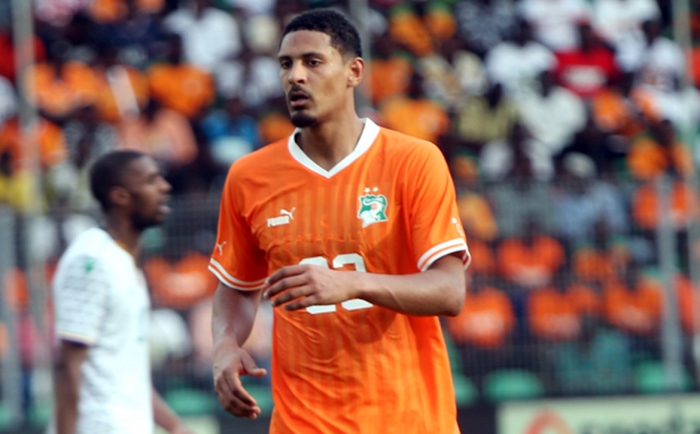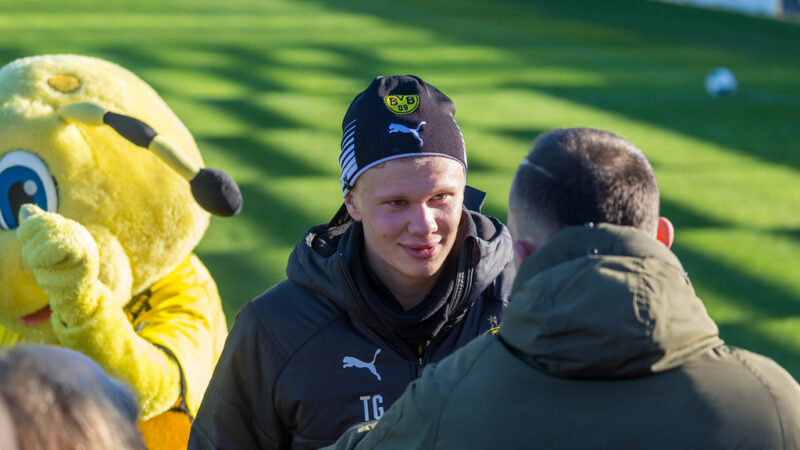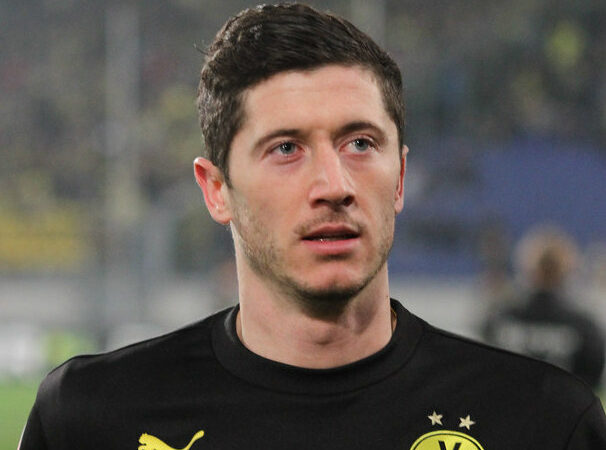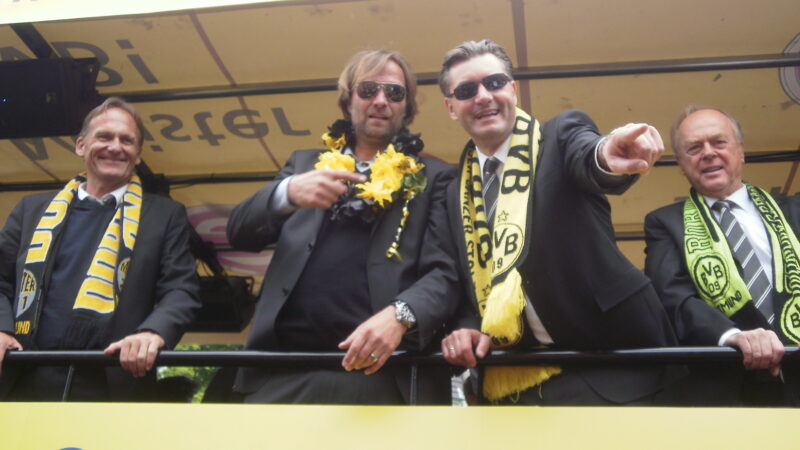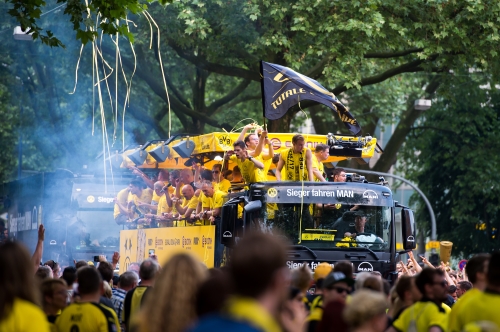Westfalenstadion: 50 years of home
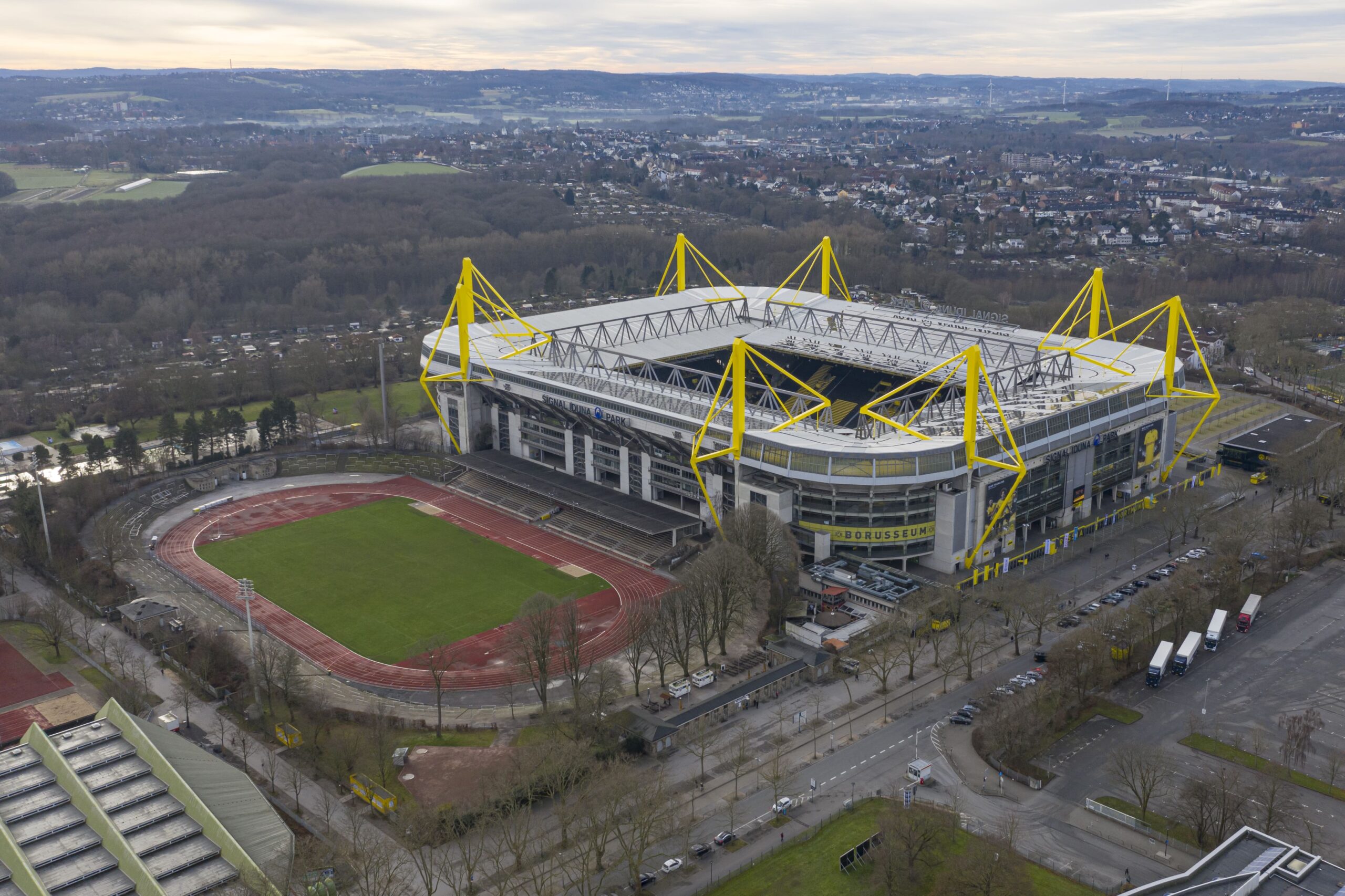
The Westfalenstadion.
This place is more than a stadium.
It’s more than some grass and four stands.
For Borussia Dortmund, it is home. For many, it is everything.
Rarely are clubs so synonymous with the places they play.
But when football fans think of Borussia Dortmund, one image springs to mind.
It’s not Jürgen Klopp or Marco Reus, it’s those black and yellow strips plastered across Signal Iduna Park’s Südtribune – or as it’s more affectionately known, the Yellow Wall.
Those tifos, those flags, those fans and that passion are what makes BVB one of world football’s most well-liked clubs by neutrals.
This ground is one of Europe’s most iconic sporting venues.
Just last week the club celebrated 50 years playing at their current home.
While other iconic arenas date further back in time, 50 years is all it has taken for this gargantuan sports complex to sit among the greats.
The stadium itself
The name ‘Westfalenstadion’ literally means ‘Westphalia Stadium’, owing to the state location of the stadium, North Rhine-Westphalia.
Dortmund drop a special-edition kit to celebrate 50 years of their stadium 🖤💛 pic.twitter.com/lcfgIBr0d5
— B/R Football (@brfootball) April 3, 2024
More commonly known as Signal Iduna Park, the ground’s naming rights were purchased by insurance company Signal Iduna in 2005.
That sponsorship deal is currently set to last until 2031.
But for all of its various sentiments and charms, Dortmund’s Westfalenstadion is first and foremost a stadium built for football.
Take the fans out of the equation, and how does the 81,365-seater rank as a ground overall?
Signal Iduna Park is the biggest football stadium in Germany, by capacity, and lies in UEFA’s top bracket of stadium categories.
It’s also the fifth biggest in Europe, only behind: Camp Nou* (Barcelona), Wembley Stadium (London), Santiago Bernabeu (Madrid), and Stade de France (Paris).
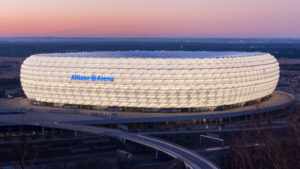
With four grandstands and 11 executive suites, it also holds the European record for average fan attendance.
In the 2011-12 season 1.37million spectators came through the doors, an average of 80,588 per game.
The whole essence of ‘die Borussen’ is the fans.
But while the Südtribune is nothing without those fans, its 24,454 capacity remains the largest terrace for standing supporters in Europe.
Where did Dortmund play previously?
From 1937 until 1974, ‘die Schwarzgelben’ played at Stadion Rote Erde (Red Earth Stadium).
The stadium now hosts Borussia Dortmund II games and athletics events.
It holds just under 10,000 people for football games and stands immediately adjacent to Signal Iduna Park.
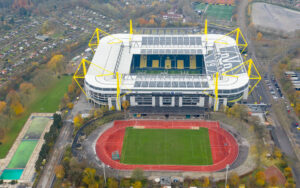
Getting bigger
With the club’s domestic and continental success in the 1950s and 1960s, more and more fans were flocking through the doors of the Rote Erde.
Plans for expansion were made in the 1960s.
But when Cologne pulled out of the running to host matches in the 1974 World Cup in West Germany, Dortmund stepped up to replace them.
With that, Cologne’s allocated funding was passed on to Dortmund, giving the club sufficient funds to complete their new build.
The city of Dortmund only had to pay 800,000 Deutsche Mark (approx. €400k) to do so, and a 54,000-seater was erected.
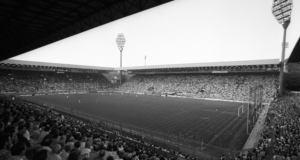
Various renovations and expansions have taken place since BVB moved into their new home in April 1974.
In fact, in 1992 UEFA regulations saw its capacity reduced to 42,800, after certain standing terraces made way for seats.
After the club’s 1995 Bundesliga title win, that capacity was soon restored to its original capacity of 54,000, as second tiers were added on to the East and West grandstands.
Just two years later, the North and South were extended too.
This followed the Black and Yellows’ Champions League triumph under Ottmar Hitzfeld.
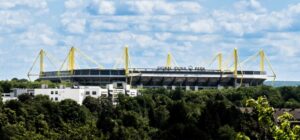
This brought the capacity up again to 68,000 and the Südtribune as we know it today was born.
More change soon followed as the corners between the stands were filled by new curved stands, as the ground was brought up to scratch ahead of the 2006 World Cup.
With those corners came the yellow pylons – at first, a mundane structural engineering feature.
Now they form part of this stadium’s iconic image; one even features on the club’s current home kit.
A glass front, undersoil heating and the famous ‘Borusseum’ – the club’s official museum (launched in 2008) – have also since been installed.
A tourist hotspot
The Yellow Wall is a sight firmly fixed upon the bucket lists of countless football fans across the globe.
While football is a sport that breeds passion on every corner of this planet, in few places can you see such a marvel like the Yellow Wall.
A single-tier stand engulfed in black and yellow. With a passion and a fan culture like no other.
It’s no surprise as to why the Westfalenstadion draws in so many tourists every week.
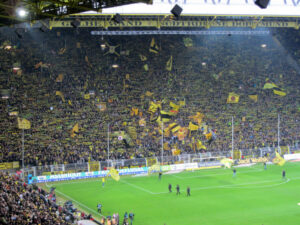
To accomodate those visiting from out-of-town, the stadium is nicely connected to the city by public transport.
Several U-Bahn (Germany’s underground railway system) stations lie in the nearby vicinity of the stadium.
The gorgeous Westfalenpark and the impressive Westfalenhallen are accompanied by stations roughly a kilometre away.
While ‘Stadion’ itself is just around the corner.
‘Dortmund Signal-Iduna-Park’ is also a popular train stop directly outside the ground. That’s just a five minute ride from the city’s main train station.
From the airport, tourists can catch a bus to Holzwickede and then ride 15 minutes on the train to the stadium, making for a half an hour journey.
Radisson Blu, B&B and Mercure also have hotels in the same area.
It’s fair to say the area is certainly well-prepared for those making progress on their bucket lists.
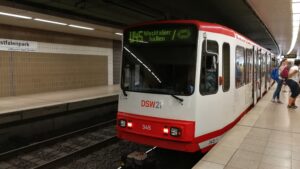
Those Westfalen Nights
The Westfalenstadion has seen an incredible amount of football.
Just two years ago, the club celebrated 1000 home games at the stadium.
Sadly for ‘die Schwarzgelben’, the occasion wasn’t matched by such festivities on the pitch, as Scottish side Rangers ran out 4-2 winners on their way to the UEFA Europa League final.
Over 800 of those matches came in the Bundesliga – the first coming in 1976, two years after they’d moved in.
More than 80 of those have come in the Champions League, as the club have firmly established their status, sitting among Europe’s elite over the years.
No match at the stadium has seen more goals than the 15 seen in Dortmund’s 14-1 win over BSV Schwenningen in the 1978 DFB-Pokal.
The club’s 2000th goal at the venue was scored in 2019 against Hoffenheim by Mario Götze – one of the club’s finest academy graduates.
That same year, the 3000th goal overall was scored by Raphael Guerreiro in a 4-0 win over Bayer Leverkusen.
When it hosts four group stage matches, one round of 16 game and a semi-final at this summer’s European Championships, Signal Iduna Park will be hosting its third major international tournament.
Salih Özcan will be well-acquainted with the stadium, as his Turkey team face group F encounters against Georgia and Portugal there.
Holders Italy face Albania in Dortmund in the tournament’s third match, while one of the favourites for the trophy, France, conclude their group stage here against Poland.
The Polish skipper Robert Lewandowski will certainly be familiar with his surroundings.
International Heritage
Just two months after its doors opened, the Westfalenstadion hosted its first major tournament.
Scotland took on Zaire at the 1974 World Cup in front of 25,000 people on the second night of the tournament.
The other three games played there that tournament all involved Johan Cruyff’s iconic Netherlands side.
As it has gone on to be for the likes of Donyell Malen and Ian Maatsen, the stadium proved to be something of a lucky omen for the team.
Holland drew with Sweden in Dortmund before beating Bulgaria and Brazil, with Cruyff and Johan Neeskens stealing the show.
Signal Iduna Park also hosted six matches at the 2006 World Cup – the only other time it has been hosted by Germany.
Before that, the stadium hosted its first, and only (to date), European final.
In 2001, the last time the golden goal rule was used to decide a European final took place in Dortmund.
BVB themselves went on to appear in the final the following year, but that season, Liverpool completed their treble of cup competitions with a win over Deportivo Alaves in North Rhine-Westphalia.
That mad final from 2001.
Liverpool 5-4 Alaves 🏆pic.twitter.com/UvlTN6aByj
— The Redmen TV (@TheRedmenTV) September 21, 2023
2006 World Cup
Five years later, the likes of Ronaldo Nazario, Ronaldinho and Kaka starred in one group match as Brazil demolished Japan.
Other group stage results included wins for Germany and Switzerland against Poland and Togo respectively, and a 0-0 draw between Trinidad and Tobago and Sweden.
Cafu and Roberto Carlos also featured as Brazil dispatched of Ghana in the round of 16 thanks to goals from Ronaldo, Adriano and Bundesliga hero Ze Roberto.
The final game played in Dortmund that summer was Germany’s first defeat at the stadium.
Jürgen Klinsmann’s side fell to a last gasp extra time defeat at the hands of eventual champions Italy.
Strikes from Fabio Grosso and Alessandro Del Piero saw Marcello Lippi’s men book their place in the final in Berlin, as Sebastian Kehl and Jens Lehmann were among those to taste defeat.
🇮🇹🇩🇪 Was Italy 🆚 Germany in 2006 the best #FIFAWorldCup match EVER??
— FIFA World Cup (@FIFAWorldCup) March 26, 2023
A special place
From Anthony Modeste’s iconic Klassiker equaliser against Bayern to Felipe Santana’s magical Malaga winner in 2013, the Westfalenstadion is the site of many memories.
Robert Lewandowski’s four-goal haul against Real Madrid. That Lewandowski title-decider against Bayern in 2012. Many Revierderby classics against Schalke.
The list goes on.
Michael Zorc. Lars Ricken. Dede. Mats Hummels. Marco Reus.
So many stars have called Signal Iduna Park home.
From Ottmar Hitzfeld to Jürgen Klopp.
This place transcends eras.
It’s more than a home.
Having experienced such history in just 50 years, who knows what the next half-century will bring.
Happy birthday, our very own Westfalenstadion.

